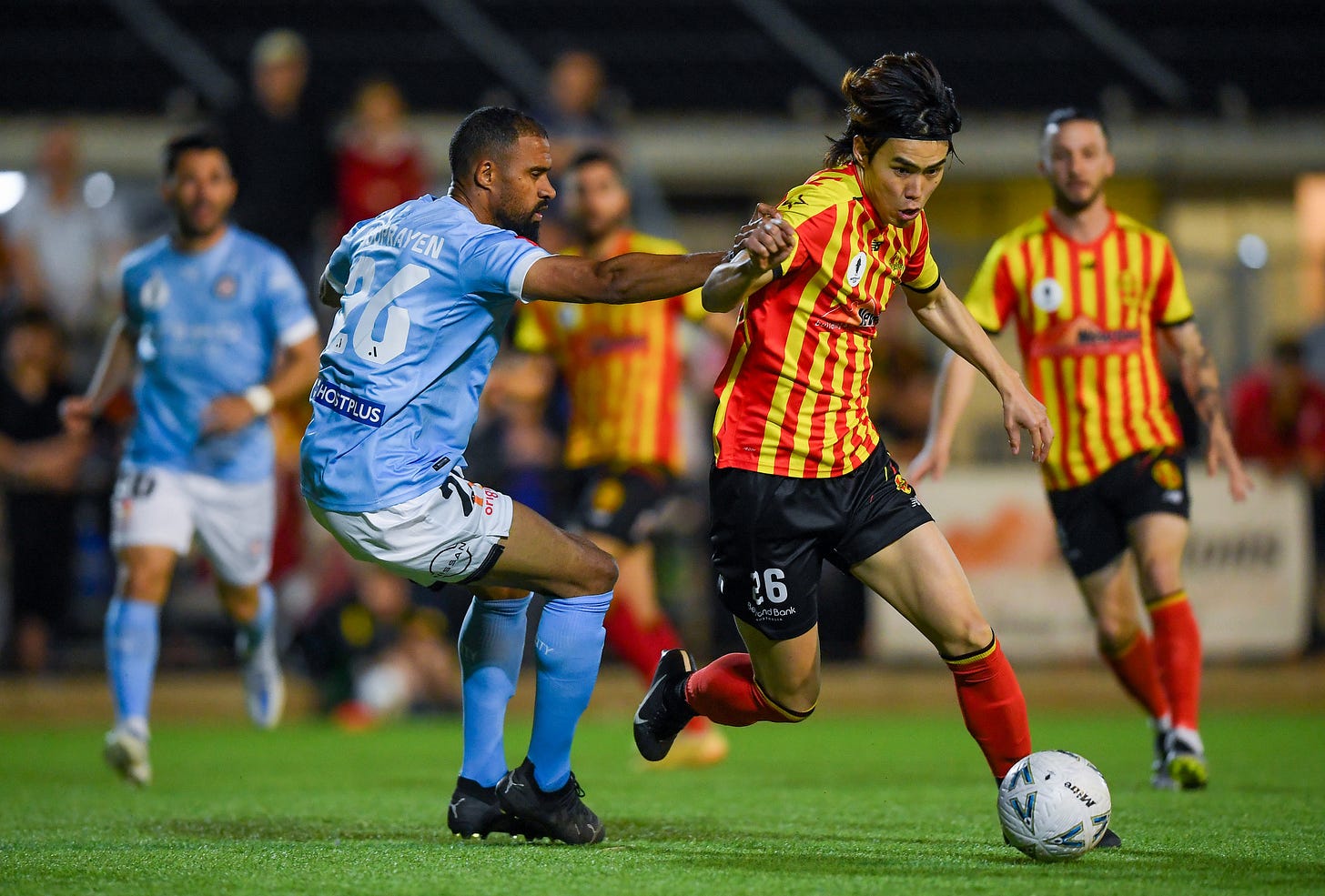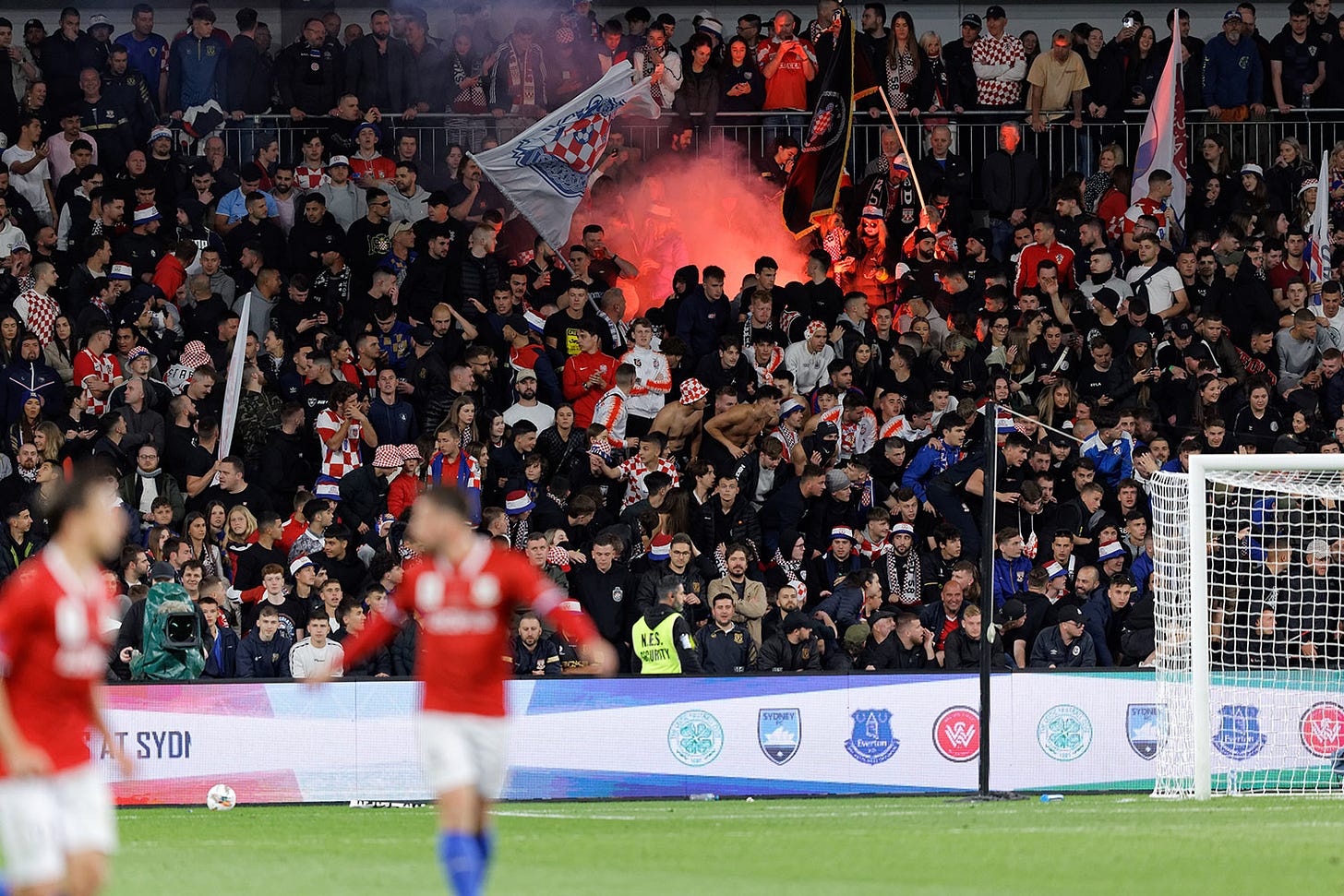How the national second division can help reclaim Australian football's lost soul
It's been 19 years since Australian football tried to permanently whitewash its history, and in the process, lost its soul. An NSD can bring that back.
There’s something special about Australia Cup games involving NPL clubs, especially those games between NPL and amateur teams and their A-Leagues counterparts.
Maybe it’s the fact that you’re so close to the pitch. Maybe it’s because you’re only metres away from Socceroos and established A-Leagues players. Maybe it’s the community aspect; friends and family meeting up, volunteers working hard to make sure everything ran smoothly and locals coming together to cheer on their local team as they go up against an A-League Men heavyweight.
MetroStars’ quarter-final against Melbourne City had all of these things and was a glimpse into why the South Australian side wants in on the National Second Division. It was a great night and a fantastic atmosphere from arguably the best semi-professional team in the state.
It was also a frustrating reminder of how atmospheres and nights like this have been suppressed by the powers that be. Whether it was the exclusion of pre-existing clubs from the A-League or the punitive National Club Identity Policy, higher-ups have tried to take football out of the neighbourhood and into the city.
The NCIP aimed to make football ‘inclusive and accessible’, but instead did anything but. The policy was the then-latest step in Australian football’s attempts to whitewash and blatantly rewrite history, all while telling migrant communities that everything they had brought to football was no longer welcome in the modern game.
Since the end of the NSL, Australian football has had a long and complicated relationship with its traditional clubs. After years of trying to erase history, only now have the first steps to reconciliation been taken, with traditional clubs being tentatively welcomed back into the fold and the NCIP being scrapped.
Still, something’s not right. While the hand-wringing and dog-whistling about ethnic tensions is gone, what’s left is quite strange. For all the good over the last few years, those 19 years of open warfare on ‘old soccer’ have taken its toll on the game. Instead of welcoming these traditional clubs back into the fold and praising their communities for everything they’ve done for the game, these storylines have become increasingly Flanderisied. Stories of volunteers who had given decades to the clubs they love have become increasingly dull foodie trips about which team has the best souvlaki or cevapi. It’s a sad turn of events for these clubs.
Watching MetroStars’ game against Melbourne City, or any of these David vs. Goliath clashes, is a reminder that the community atmosphere of these local clubs was squashed as Australian football systematically tried to ostracise and kill its own, all to pander to theatregoers who have not and continue to not care about the game, if the crowd numbers for the A-Leagues are anything to go by.
The foundation of the A-League, as important as it has been in football’s growth here, is the prime example. As the NSL was dying, and traditional clubs were becoming parodies of themselves, the A-League was the final straw for many who had dedicated years to the game. They gave up on a sport they felt had given up on them.
Given the whole point of the A-League was to take football out of the neighbourhood and into the forefront of public consciousness, this makes sense. However, while the intentions were pure, the ramifications were wide-ranging and arguably, even damaging.
One of the biggest impacts it had was on youth development. During the NSL days, the vast majority of the Socceroos team were European regulars, boasting league and even Champions League winners. After these pathlines were split off, and husks of these traditional academies were implemented at A-Leagues clubs, the drop-off was inevitable. The end of Australia’s production line of international-standard players and the ethnic cleansing of the domestic game have clear but tragic links. Only now is the Australian talent pool starting to get anywhere near the Golden Generation, after development slowed down for a good 15 years, barring some exceptions.

On a more abstract level, the creation of the A-Leagues, for all its good, has made Australian football lose its soul. Aside from the Sydney and Melbourne Derbies, there are no epic battles for Australian football’s heart, something common in the NSL. The genius of the Sydney Derby is that it taps into something much bigger than football; it harnesses the geographical, cultural and socio-economic divide of Sydney as a city. A lot of other rivalries with the A-League feel relatively manufactured by comparison; the ‘Battle of the Bridge’ between Western United and Melbourne Victory, or the APL’s shameful attempts to force a rivalry between Macarthur and Western Sydney in particular feel like little more than focus-group tested marketing strategies.
Again, this has to do with roots. The best derbies or rivalries in the A-League play into pre-existing battle lines, something that the NSL didn’t have a problem with. The Original Rivalry is another good example of this, as it has been able to tap into a pre-existing mutual dislike between South Australia and Victoria, while also being allowed time to develop its own history. Traditional clubs had this sorted, as these rivalries existed because of pre-existing ethnic, cultural and social rivalries between the communities behind these clubs. They didn’t have to be forced. Sydney Olympic vs. Sydney City, Melbourne Knights vs. Footscray JUST or Adelaide City vs. West Adelaide - all of these rivalries were allowed to blossom over time and immerse themselves in local communities. You know what these clubs stand for, who they represent and where they come from. Can you say the same for a few of the current A-Leagues teams?
Despite bearing names of locations, there are A-Leagues teams, particularly expansion sides, that feel like catchment pools arbitrarily chucked in wherever local participation numbers are high. This isn’t a knock on the clubs by any means, but more on administrators who think that simply having expansion franchises pop up in areas with little interest in local football is a good idea. You know what groups a team like South Melbourne represents, can you say the same for Western United? What about APIA Leichardt compared to Macarthur? Do any of the teams in Queensland’s NPL better represent Brisbane than Brisbane Roar, who have played more games in Redcliffe than in Brisbane over the last 3 years? If A-League clubs aren’t able to represent their communities effectively, then surely something has gone wrong here. Administrators have tried to whitewash football’s history to create a mass, universal, popularised competition, and in the process, made Australian football lose its soul.
While Australian football has tried to hide its history for the better part of two decades, an NSD can bridge that gap. Football shouldn’t have to be ashamed of its history, it should embrace it. finally bringing these traditional clubs back into the fold can not only bring the game’s history full circle again.
The true greatness of the Australia Cup isn’t in the semi-pro who scores against an A-League side or the amateur side that manages to ride the wave to the knockout rounds (see Mindil Aces’ run to the Round of 32 last year), but more in what it does for the game as a whole. No other competition, in no other sport, becomes as interconnected as football during the Australia Cup. No other sport provides a platform for such unique stories to be told. The Australia Cup provides this for a few months a year and has been a much-needed addition to the Australian football scene. As important as the cup is right now, imagine if this happened every week.
An NSD would finally bring together these clubs, clubs with decades of history into the footballing mainstream. Rather than an NPL competition that is almost entirely disconnected from the A-Leagues, these clubs can have the chance to genuinely be a part of the Australian football pyramid. Bring in promotion and relegation after a few years, keep the Australia Cup and old soccer and new football are finally not just integrated, but properly functioning within the same competition framework.
Clubs like Oakleigh Cannons or Marconi Stallions could have the opportunity to fight for ultimate glory in the A-League Men, while established A-Leagues clubs like Macarthur or Newcastle could be forced to mix it in the second tier. Underperformance in the A-Leagues could finally have a consequence, while clubs in the NPL could finally have something to aspire to, rather than simply treading water in their local state competition.
Of course, it is much easier said than done to implement a second tier, especially with semi-professional teams where the necessary finances are hard to come by. The challenge becomes even harder in a country like Australia, given the small population spread out over such a massive geographical area, and that’s not even mentioning the existence of three other high-profile sports all competing for eyes and dollars. The risk is worth the reward, though. If the NSD is successful, not only will Australian football reconcile with its history, but it will be the only professional sporting competition in the country to not be a ‘closed shop’. It’s something that is very exciting to think about.
Recently, Australian football has become increasingly characterised by its full heart and empty soul, an idea brilliantly put by Ante Jukic.
The national second division can help reclaim that missing soul.


